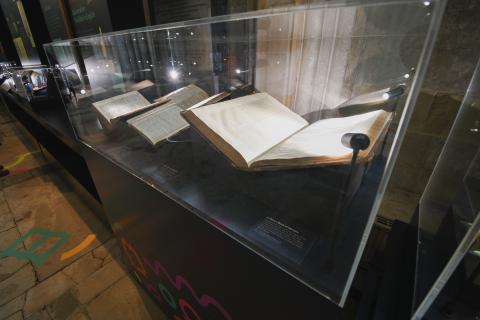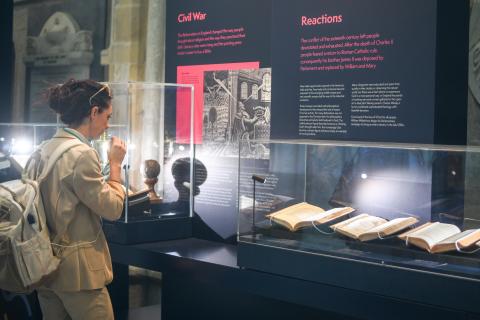Reached by a narrow spiral staircase from the Treasury and Shop in the North Transept, our Library is a hidden gem within the Cathedral.
With origins stretching back to the medieval period, the Library has moved through various locations before finding its present home in 1969. Today, it holds around 10,000 volumes, offering an extraordinary window into the life of the Cathedral, the city, and the wider world.
As part of our 950th anniversary exhibition, Religion, Rebellion & Reformation, now extended until February 2026, several of the library’s volumes are on display. Together they chart not just the history of faith in Sussex, but also wider currents of English life and thought across the centuries.
The Library’s collection has been shaped by the upheavals of history. Much of its earliest material was swept away during the Reformation and the Civil War, but it was rebuilt through private gifts and acquisitions. Over time, it grew to encompass theology and liturgy, alongside cookery, philosophy, art, and music - reflecting a breadth that makes it unique among ecclesiastical libraries.
Everyday knowledge alongside great theology
Among the most surprising objects in the Library’s collection featured in Religion, Rebellion & Reformation is Eliza Smith’s The Compleat Housewife (1734), known as the first recipe book to be printed in Colonial America and the earliest book by a woman in the library collection.
“The presence of a wonderfully everyday object such as this in the exhibition is a reminder that the Library was never solely about lofty theological debate. Practical knowledge - culinary, medical, and domestic - sat alongside the works of great thinkers.”
Reverend Vanessa Baron, Canon Treasurer and curator of Religion, Rebellion & Reformation
Opening doors to learning
The presence of this volume in the Cathedral Library can be explained by the fact that, unlike many ecclesiastical libraries, Chichester’s served as a public library in the 17th century - a period of significant intellectual activity and a revival of the Cathedral’s collections. Though not a public institution in the modern sense, this relatively early initiative made the Library accessible to a wider audience, including women. It was within this culture of openness that a work such as The Compleat Housewife found its place, reflecting the blend of practical, domestic knowledge with the theological and scholarly works that defined the Library’s holdings.
This wider accessibility meant the Library’s influence reached well beyond the Cathedral walls, drawing scholars, clergy, and laypeople alike into conversation with ideas that were shaping Europe.
“This period of public access gave the Library a distinctive role in Chichester’s life. Having a library of this stature in Chichester created a culture of enquiry that helped shape the character of the city.”
Reverend Vanessa Baron
Today, the Library continues this tradition, opening its doors to the public on regular occasions.
Opening up scripture

Another highlight of the exhibition is a rare 16th century copy of the Geneva Bible, affectionately known as the “Breeches Bible,” for its distinctive translation of Genesis 3:7. Outlawed in 1616, this version was technically illegal, yet it found its way into homes across England. Printed in Gothic script to resemble the authorised Bishop’s Bible, it would not have looked out of place under Queen Mary’s reign, allowing readers to study scripture without drawing undue attention.
What made the Geneva Bible so radical were its extensive study notes running down the margins, designed to help ordinary readers interpret and understand the scriptures for themselves. In doing so, it exemplified the Library’s wider role in making ideas - theological, moral, and intellectual - more accessible, encouraging engagement and debate beyond the pulpit.
Voices of change
One of the most remarkable figures connected with the Cathedral Library is Reginald Peacock, Bishop of Chichester from 1451 to 1457. The exhibition features his writing, A Treatise proving Scripture to be the Rule of Faith c1450, a groundbreaking work that made him the first theologian in England to write systematically in English rather than Latin. By doing so, Peacock opened complex theological ideas to a much wider audience.
Canon Vanessa describes this as: “An interesting story of the democratisation of ideas and a key transition from a largely visual and oral culture to what is going to become a much more written culture. Then we get into the concept of the Bible in English and the absolute explosion of ideas.”
Though his writings led to condemnation and exile, Peacock’s works endure - including the rare copy preserved in the Cathedral Library. They mark a milestone in the long journey toward open debate and individual interpretation in matters of faith.
(Discover more in our blog, Chichester Bishops who helped changed the world).

A living heritage
From cookery to controversy, scripture to scholarship, the books featured in our exhibition carefully chosen from the Cathedral Library reveal more than the history of a collection: they tell the story of a city shaped by ideas. For over nine centuries, the Library has been a place where knowledge could be preserved, questioned, and shared - helping the Cathedral, and Chichester itself, to become a crossroads of faith, culture, and enquiry.
Religion, Rebellion & Reformation is part of Chichester Cathedral’s 950th anniversary programme and is on display until February 2026. The exhibition is free to visit, with a suggested donation of £7.00 per person. The Cathedral is open from Monday – Saturday 9.00am – 5.00pm and on Sunday from 12.30pm – 2.30pm.